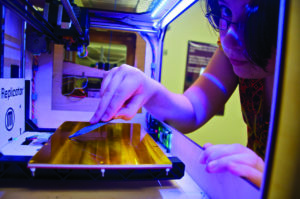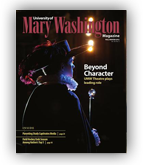
In UMW’S Think Lab, Alice Watkins uses a 3-D printer called a MakerBot to complete an independent study in wearable art. The first-year seminar, “Mashups and MakerBots,” teaches UMW students how to use the popular and increasingly affordable machines. Photo by Kimmie Barkley ’14.
3-D printing has taken off in the last few years as the technology has become more affordable and widely available. And as often is the case with emerging technologies, it’s landed at UMW.
Today a Simpson Library classroom – dubbed the Think Lab – is home to 3-D MakerBot printers and a first-year seminar called Mashups and MakerBots. Instructional Technology Specialist Tim Owens and Professor of Education George Meadows team up there to teach printing, electronics, and robotics.
This fall, 16 first-year students from across disciplines are learning the basics of circuitry and automation while designing 3-D objects, from the simple – think key rings and iPad covers – to intricate works of art.
Seven of Meadows’ master of science in education students are using the lab to get to know the technologies, too.
Meadows hopes the graduate students’ time in the Think Lab will make them more confident and willing to try new things in the classroom when they are teachers.
And they will be better prepared to meet national STEM standards.
“We like to see all our teachers become leaders in the classroom,” Meadows said.
EDUCAUSE, a respected community of higher education IT leaders and professionals, was so impressed with Meadows’ and Division of Teaching and Learning Technologies’ (DTLT) work with 3-D printing and their having built a Makerspace at UMW that they covered it in their Learning Initiative article 7 Things You Should Know About 3-D Printing.
UMW studio art major Alice Watkins ’13 learned about 3-D printing in her sculpture class last year when Professor Carole Garmon took students to visit DTLT and the department’s MakerBot.
“I fell in love with it,” Watkins said.
Today, Watkins is a student aide in the Think Lab, and she is using the technology for an independent study in wearable art. She received a UMW undergraduate research grant to purchase a 3-D printer for her work.
Recently in the Think Lab, Watkins watched the MakerBot as it whirred and hummed while a spool of plastic thread slowly transformed a flat image on a computer screen into a three-dimensional object. She picked up the small, gray item from inside the printer and placed it alongside others that will make up the art-as-garment she is creating.
Watkins was struck, she said, by how members of DTLT and faculty across disciplines have supported her art project.
“That is something that always fascinates me about this university, how open and full of creative communication it is,” she said. “I’m glad the school is supportive of my curiosity. I’m blown away.”
